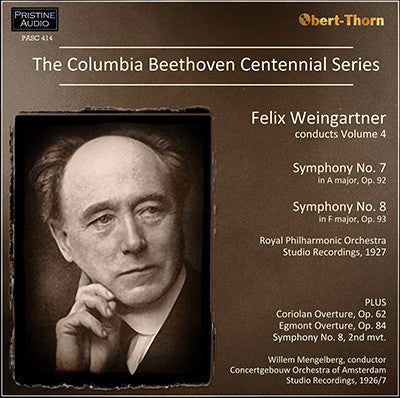
This album is included in the following sets:
This set contains the following albums:
- Producer's Note
- Full Track Listing
- Cover Art
The Columbia Beethoven Centennial Symphony Series, Volume 4
Penultimate issue in this groundbreaking Symphonic series, first issued in 1927, in new Mark Obert-Thorn transfers
This volume is the fourth of five which will reissue, for the first time in one series, the complete symphony cycle which English Columbia commissioned to commemorate the centennial of Beethoven’s death in 1927. The first four symphonies were assigned to British conductors (Henschel, Beecham, Wood and the Northern Irish Harty) while the remainder were given to Weingartner, already generally acknowledged as a Beethoven specialist.
For the Seventh and Eighth Symphonies, Weingartner was returning to scores he had only relatively recently recorded for Columbia using the old acoustical process. In the Seventh, he restored a cut he had made in the Scherzo in the previous nine-sided version, while the remade Eighth took one side less due to the elimination of a large overlap of repeated music in the third movement. Both of the present versions are swifter than their 1936 remakes, but the differences are not as marked as those between his 1927 and 1933 versions of the Fifth Symphony (detailed in the notes to Volume 3).
The two overtures date from the Concertgebouw Orchestra’s first recording sessions in May, 1926. The early electrical sound is noticeably more primitive than that of the symphonies, showing the great advances Columbia had made over the intervening months. The single movement from the Eighth Symphony was included as the filler side to Mengelberg’s recording of Cherubini’s Anacreon Overture. While not part of the Centennial Symphonies series per se, these sides have been included not only to fill out an otherwise short program, but also because, along with Henry Wood’s Leonore Overture No. 3 in Volume 1 and the symphonies, they comprise the complete electrical orchestral recordings of Beethoven which Columbia had in print by the end of the Centennial year of 1927, (excluding Louis Zimmermann’s recording of the Violin Concerto, released only in Holland).
The sources for the present transfers were American Columbia “Viva-Tonal” pressings. While these are usually the quietest versions available, a higher-than-average amount of surface noise will be noticeable in the Mengelberg items. When played using the typical recording curve for the early electric era, these sides sound dull and bass-heavy; however, by playing them with a “flat” equalization and then significantly boosting the upper frequencies, the balance and detail of the original recordings comes into focus, albeit at the expense of significantly increased hiss. The severe speed fluctuations of the originals have been corrected through the application of Celemony Capstan, allowing the performances to be heard with rock-solid pitch for the first time since the original recording sessions.
Mark Obert-Thorn
-
BEETHOVEN Symphony No. 7 in A major, Op. 92
Recorded 20, 25 – 26 January 1927 in the Scala Theatre, London
Matrix nos.: WRAX 2383-2, 2390-2, 2391-2, 2392-1, 2393-1, 2394-2, 2397-2, 2398-2, 2399-2 & 2400-2
First issued on Columbia L 1898 through 1902 -
BEETHOVEN Symphony No. 8 in F major, Op. 93
Recorded 27 – 28 January 1927 in the Scala Theatre, London
Matrix nos.: WRAX 2412-2, 2413-2, 2404-2, 2405-2 2406-2 & 2407-2
First issued on Columbia 1903 through 1905
Royal Philharmonic Orchestra
Felix Weingartner conductor
-
BEETHOVEN Coriolan, Op. 62 – Overture
Recorded May, 1926 in the Concertgebouw, Amsterdam
Matrix nos.: WAX 1546-2 & 1547-2
First issued on Columbia L 1848
-
BEETHOVEN Egmont, Op. 84 – Overture
Recorded May, 1926 in the Concertgebouw, Amsterdam
Matrix nos.: WAX 1544-3 & 1545-1
First issued on Columbia L 1799
-
BEETHOVEN Symphony No. 8 in F major, Op. 93 - 2nd Mvt.: Andante molto moto
Recorded 10 June 1927 in the Concertgebouw, Amsterdam
Matrix no.: WAX 2844-1
First issued on Columbia L1973
Concertgebouw Orchestra
Willem Mengelberg conductor
Fanfare Review
This continues Pristine Audio’s reissue of British Columbia’s complete Beethoven symphony series, the first to be issued on electrical recordings. To get down to basics, although they are very important historically, neither of these performances can be called “competitive” no matter how good they may have sounded to 1927 ears. Although they could hardly be called “self-effacing,” the performances strike me as solid, conventional readings. The violins sound a little thin but they still dominate the proceedings much of the time. Weingartner makes no attempt to observe Beethoven’s metronome markings, possibly because he thought them invalid, so tempos tend to be on the moderate side. The basses seem more audible later in the recording of the Seventh than they did in the first movement, for whatever reason. Few repeats are observed, as was apparently the case in those days if we can believe the evidence on recordings from the monaural era. In the Eighth Symphony, he observes the first and third repeats in the third movement. As in the Seventh, he skips the exposition repeat in movement one. I mention these omissions not because they particularly bother me but because they do bother some listeners. I would call his tempos in these symphonies “middle-of-the-pack” with no extremes one way or the other. I could say the same about Mengelberg’s Egmont and Coriolan overtures, which are more vividly recorded. I await Weingartner’s first electrical Ninth, since his second one is one of my very favorites.
James Miller
This article originally appeared in Issue 38:2 (Nov/Dec 2014) of Fanfare Magazine.

